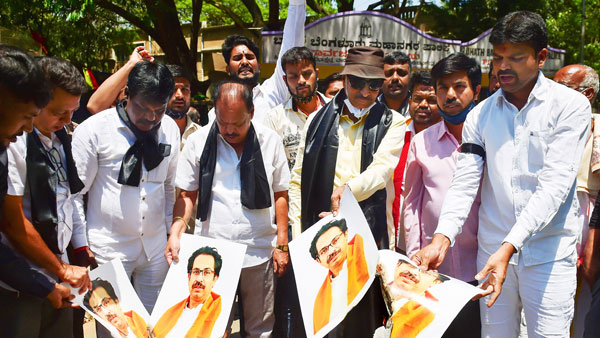
Explained: Why Maharashtra and Karnataka are in midst of a border dispute?
The border dispute between Maharashtra and Karnataka dates back to 1956 when State Reorganisation Act came into effect, according to which the states were reorganised based on linguistic lines.
New Delhi, Nov 30: The Supreme Court on Wednesday will hear the six-decade-old Belagavi border dispute between Maharashtra and Karnataka. Karnataka Chief Minister Basavaraj Bommai, meanwhile, is in New Delhi and has held discussions with senior advocate in the state's legal panel Mukul Rohatgi.

What is the border issue between the two states? When did it start? Here are the answers.
The dispute between the two states erupted after State Reorganization Act in 1956 came into effect, but it was opposed by Maharashtra which demanded Marathi- speaking border areas including Belagavi (Then Belgaum) be included into Maharashtra.
Belagavi, Vijayapura, Dharwad and Uttara-Kannada were part of the erstwhile Bombay Presidency, but during the reorganisation of states on linguistic lines, Belagavi and the surrounding villages were included in Mysore Princely state (now Karnataka). Maharashtra claims that the said regions have majority of Marathis.

According to an 1881 census, Belagavi had a population of 864,014 residents. While 556,397 (64.39 per cent) of them were Kannada speakers, 225,008 (26.04 per cent) spoke Marathi. However, the political scene changed by 1940s as Marathi leaders dominated politics and rejected the census report.
After the State Reorganization Act, Maharashtra invoked Section 21 (2) (b) of the Act, and submitted a memorandum to the Ministry of Home Affairs raising its objection to Marathi- speaking areas being integrated to Karnataka. It wanted an area of 2,806 square miles including 814 villages, and three urban settlements of Belagavi, Karwar and Nippani to be part of Maharashtra.
Mahajan Commission Report
As the dispute could not be solved, the Government of India constituted the Mahajan Commission headed by Supreme Court's retired Chief Justice Mehr Chand Mahajan on 25 October 1966. In its report, the one-man commission granted 262 villages in the disputed region to Maharashtra which wanted to integrate 814 villages besides Belgaum, while Karnataka, which had demanded 516 villages, got 247 villages.
The report rejected Maharashtra's claim on Belgaum city.
Considering 1961 census, the Mahajan Commission refused to grant Belagum to Maharashtra as it was surrounded by Kannada-speaking areas on all sides. The commission said that its decisions on border dispute were not based on the number of Marathi schools and students in Belagavi. The report noted that Maharashtra's claim is of recent origin. Although the report was tabled in Parliament, Maharashtra MPs, especially from the treasury benches, did not vote against the amendment of Belgaum being part of their state.

"Maharashtra's claim for Belgaum is of recent origin. Though tabled in Parliament, Maharashtra MPs, especially from the treasury benches, did not vote against the amendment of Belgaum being part of their state. Belgaum is a cosmopolitan city. In 1920, when the AICC session was held in Belgaum, not a single leader from Maharashtra including NC Kelkar demanded that it be part of that state. Geographically, Kannada areas surround the city of Belgaum on three sides and by a smattering of villages belonging to Maharashtra on the fourth. Reorganisation will cause extreme hardship. Status quo should be maintained. From the records of rights of Belgaum city, it is seen that a majority of lands belong to Kannadigas. All the original records in the offices of the mamlatdar and collector are in Kannada. "On the appreciation of the whole material and assessing it objectively, I have reached the conclusion that I cannot recommend the inclusion of Belgaum city in the state of Maharashtra," an excerpt from the Mahajan Commission report of 1966 said.
It has to be noted that the commission had recommended Khanapur taluk, which had thick forests and is the origin of the Malaprabha river, to be integrated with Maharashtra.
However, the Maharashtra government rejected the report while Karnataka demanded a status quo. Later, Karnataka started demanding the implementation of the commission report.
In 2006, the matter reached the Supreme Court after the Maharashtra government filed a petition in the Supreme Court staking claim over Belgaum city. The state government cited, "feeling of insecurity among the Marathi-speaking people living in Karnataka, in the recent days."
Over the years, there have been numerous protests in the border regions with the politicians raking up the issue every now and then and adding fueling into fire. To consolidate the state's claim on Belgaum, the Karnataka government Suvarna Vidhana Soudha in the city which will be used for a week every year. It was expressly constructed at a cost of Rs 400 crore to counter Maharashtra's claim to the area.


 Click it and Unblock the Notifications
Click it and Unblock the Notifications

































